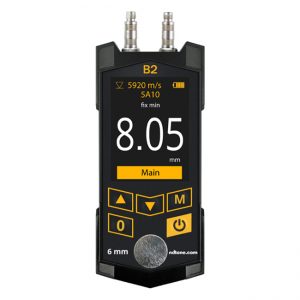Many industries need a method for material checking to confirm that structures and parts of machines are trustworthy and safe for use. Different methods are used to measure thickness. The Rimlas Ultrasonic Thickness gauge is one of the most powerful and non-destructive devices. This device is highly effective and accurately measures high-frequency sound wave material thickness. Making it essential for various industries like aerospace, automotive, manufacturing, and the oil & gas industries.
In this blog, we will discuss why ultrasonic thickness gauges are necessary for material inspection, how they work, their features, and their benefits. Let’s see in the next section what an ultrasonic thickness gauge is in detail.
What is an ultrasonic thickness gauge?
An ultrasonic thickness gauge is a thickness measurement device that helps to measure the thickness of material using ultrasonic sound waves. It works by emitting a high-frequency pulse that travels through the material and reflects from the opposite surface. By measuring the time it takes for the pulse to return, the device measures the thickness of the material without any error. The instrument is mostly used for measuring metals, plastics, ceramics, glass, and mixed materials, provided that products fulfill the safety and material quality. Now, we need to know the reasons to choose the ultrasonic thickness gauge.
Reasons to Choose the Ultrasonic Thickness Gauge
1. Non-Destructive Testing (NDT)
Using an ultrasonic thickness gauge is the best advantage in that it is a non-destructive testing (NDT) method. On the other hand, using the traditional method needs cutting or damaging the sample; the rimless ultrasonic thickness gauge measures the thickness without damaging or altering the material. This is important for industries that require maintaining the integrity of the components and structures.
2. Error-free Results and Trustworthy Measurement
With the help of this instrument, you can easily measure the thickness of the material without any single error.
3. Detection of Corrosion and erosion
If the materials come into contact with moisture, the environment, and chemicals, they may rust and model down. The ultrasonic thickness gauge helps to detect quickly and allows the user to take action before the damage.
4. Creativity in Material Analysis
The ultrasonic thickness gauge can measure the various types of material that
- Metal (steel, copper, aluminum, etc.)
- Plastics and polymers
- Ceramics and Glass
- mixed material
This innovation makes it a useful device for engineers, manufacturers, and quality control professionals.
5. Quick result
By using this device, users can rapidly get the result. It is made with advanced technology that can easily inspect and save time and increase.
Productivity.
Use of Ultrasonic Thickness Gauge
1. Oil & gas Industry
In the gas and oil industries, they use the ultrasonic thickness gauge to help pipelines and storage tanks observe structural integrity and prevent leaks and failures.
2. Aerospace and Aviation
A specific thickness measurement device is required for the safety and optimal performance of aircraft components. The ultrasonic thickness gauge is mostly used in aircraft manufacturing and maintenance.
3. Automotive Industry
In the car manufacturing industry, an ultrasonic thickness gauge is used to measure the metal and plastic components to check the quality of the products.
4. Power Plants
In power plants ultrasonic thickness gauge is used to analyze the turbines, boilers, and pipelines to ensure an effective process.
5. Infrastructure & Construction
The construction of bridges, tunnels, and buildings needs frequent thickness measurements to maintain structural quality and safety.
Now, let’s see in the next phase how to use an ultrasonic thickness gauge.
Process to Use Rimlas Ultrasonic Thickness Gauge
Use an ultrasonic thickness gauge to get proper results. Follow the given steps to get accurate results: –
- Ready surface: Clean the surface to remove the dirt, rust, or coatings to get the readings without any error.
- Calibration: Set up the instrument according to the type of material and sound velocity.
- Applying Liquid: Applying a gel or liquid to ensure transmission of ultrasonic waves properly.
- Taking Measurement: Place the device on the material and record the thickness reading shown on the gauge.
- Data Analysis: Save and analyze the data for the maintenance report.
Conclusion
In this blog, we explored the ultrasonic thickness gauge, its uses, and its basis. The Rimlas Ultrasonic Thickness Gauge is a useful device for industries. It can check for rust and corrosion and measure thickness with accuracy. It works in various environments, making it essential for quality control. You can also use the LEEB Hardness Tester to check the hardness of the metal.
If you are looking for the best gauge to measure the thickness, then you must use the Rimlas Ultrasonic Thickness Gauge. It has many advanced features that help you easily use the device and give the result without any error. Thank you for your patience in reading this blog.
